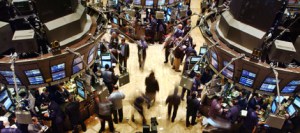Short Term

September 17, 2024 | Daily JAM, GLD, GOLD, Jubak Picks, Perfect Five-ETFs, Short Term, Volatility |
I think you want to own gold–through something like the SPDR Gold Shares ETF (GLD) right now to profit from decreasing interest rates at most of the world’s central banks, from global macro uncertainty, from the possibility of domestic violence in the United States around the election, and from what sure looks like a train wreck in U.S. fiscal policy.
In the short term. Say six to nine months–maybe even a year–from now. The SPDR Gold Shares ETF is up 24.84% for 2024 as of the September 16 close. In that same time period I think shares of gold mining companies are likely to lag the gains in gold. Shares of Barrack Gold (GOLD), the world’s second largest gold producer, are up just 15.09% in 2024.

September 14, 2024 | Daily JAM, Short Term, Volatility |
The Federal Reserve will cut its benchmark interest rate at the Wednesday, September 8, meting off its Open Market Committee. It will be the first in a series of cuts that is likely to include 3 cuts in 2024 (at the September, November and December Fed meetings. The odds of a rate cut are a solid 100%. But there is high drama about the size of the initial cut to the Fed’s benchmark interest rate, now at a target range of 5.25% to 5.50%.

September 13, 2024 | Daily JAM, Morning Briefing, Short Term |
U.S. consumer sentiment rose to a four-month high in early September. The sentiment index from the University of Michigan increased to 69 from August’s 67.9, preliminary figures showed Friday. The median estimate in Bloomberg’s survey of economists called for a reading of 68.5. The biggest contributors to the improved sentiment reading were the tamest short-term inflation expectations since the end of 2020 and anticipation of a drop in borrowing costs as the Federal Reserve begins to cut interest rates.

August 25, 2024 | Daily JAM, NVDA, Short Term |
It wouldn’t hurt to be a crab this week so you’d be able to independently rotate your eyes to look in two different directions. With one eye this week, investors and traders will want to watch the Wednesday, August 28, earnings report from Nvidia (NVDA) to see if tech stocks can continue to regain the momentum they lost in the market tumble of early August.And with the other eye, watch for reaction to Fed chair Jerome Powell’s Friday Jackson Hole speech that promised an initial interest rate cut at the Fed’s September 18 meeting. Now market attention shifts to how many rate cuts there will be in 2024. Anything less than full 100 basis points at the September, November, and December meetings will disappoint some bond traders.

August 24, 2024 | Daily JAM, Short Term |
Speaking at the Kansas City Fed’s Jackson Hole central bankers gab fest, Jerome Powell, the chair of the Federal Reserve, clearly said on Friday that the central bank was poised to cut interest rates at its September 18 meeting. “The time has come for policy to adjust,” Powell said. “The direction of travel is clear, and the timing and pace of rate cuts will depend on incoming data, the evolving outlook and the balance of risks.” He then added: “We will do everything we can to support a strong labor market as we make further progress toward price stability.” All this shifts market attention from WHEN the Fed will begin cut interest rates to HOW FAST those cuts will be.

August 21, 2024 | Daily JAM, Morning Briefing, Short Term |
Monthly employment reports overstated the number of job created by the U.S. economy by 818,000 in the 12 months that ended in March 2024, the Labor Department reported on Wednesday, August 21. That revision, part of the annual process that reconciles job reports derived from monthly surveys with state records, says that employers added about 174,000 jobs per month on average during that period, down from the previously reported pace of about 242,000 jobs. That’s a drop of about 28%.

August 16, 2024 | Daily JAM, Morning Briefing, Short Term |
What happened to all that selling? And the conviction that the U.S. economy ws headed for a recession? The Standard & Poor’s 500 finished Thursday, August 15, with another up day for a 6-day rally that has pushed the index up 6.6%.Treasury yields surged with the yield on the 2-year Treasury, the maturity most sensitive to shifts in sentiment about the direction of Federal Reserve interest rate policy, climbing back above 4%. The S&P 500 climbed 1.6% on the day. The Nasdaq 100 added 2.5%. The small-cap Russell 2000 gained2.5%. The CBOE Volatility Index, Wall Street’s “fear gauge,”the VIX, dropped back to near 15, below its long-term average, and hugely below its August 5 close at 38.57. The proximate cause of the rebound rally? Three reports showing that the U.S.consumer is alive, well, and still buying stuff.

August 8, 2024 | Daily JAM, Short Term |
I’d worry less about the U.S. slipping into recession if the rest of the global economy wasn’t so challenged on growth. For the first quarter of 2024, the annual growth rate in the European Unpin was just 0.6%, for example. And now we have data out of China showing that export growth unexpectedly slowed in July. That signals cooling global demand at a moment when China needs export growth to make up for a sluggish domestic economy. Exports rose 7% in July in dollar terms from a year earlier, falling short of economists’ median forecast of a 9.5% gain.

August 7, 2024 | Daily JAM, Morning Briefing, Short Term |
The options market is implying the S&P 500 Index will move 1.2% in either direction that morning on the report on U.S. initial and continuing claims for unemployment.

August 6, 2024 | Daily JAM, Short Term |
Briefly on Monday’s scary stock market volatility, traders and investors decided that the Federal Reserve would make its first interest rate cut at its September 18 meeting not a “business-as-usual” 25 basis points but a “market emergency” 50 basis points. On the CME FedWatch tool the odds of a 50 basis point cut jumped to 85% from just 13.2% on July 30

August 6, 2024 | Daily JAM, Morning Briefing, Short Term |
Today, Tuesday August 6, the Nikkei 225 index closed up 10.23% in Tokyo. That erased most of Mondyay’s 12% loss. And it led to the U.S. futures market opening higher and U.S. stock indexes moving up today. At the close in New York, the Standard & Poor’s 500 was ahead by 1.03%, and the Dow Jones Industrial Average was higher by 0.76%. The NASDAQ Composite had gained 1.03% and the small cap Russell 2000 had added 1.23%.The volatility eertainly isn’t over but today the market is following the usual patterns–with buying on the drop emerging after a big sell off–and that’s a big relief after the panic-inducing movement of the last three sessions. Those on Wall Street trying to figure out where we are in the unwinding of the yen/dollar carry trade that has lent so much intensity of the drop ay that the selling of dollar assets to buy ten isn’t over. Which makes sense.

August 5, 2024 | Daily JAM, Morning Briefing, Short Term |
Okay, the correction in the NASDAQ and the near correction in the Standard & Poor’s 500 isn’t all about Japan. U.S. stock valuations are stretched. Air is coming out of the AI bubble. The U.S. economy is slowing But to me those factors don’t explain the stunning rapidity of this drop. Nor why the biggest damage to any global market is taking place in Tokyo. To me this event has all the hallmarks of a move that has more to do with the unwinding of massive speculative trades than with anything we might label “fundamentals” or “macro economics.”Edward Yardeni, president of Yardeni Research and one of the smartest long-time observers of the financial markets I follow, points his finger at Japan and the surprise interest rate increase from the Bank of Japan that has led to a rapid unwinding of the speculative dollar/yen carry trade.













